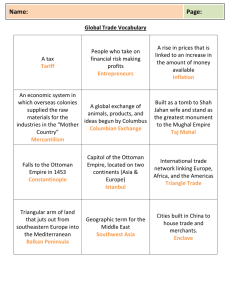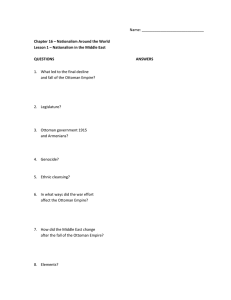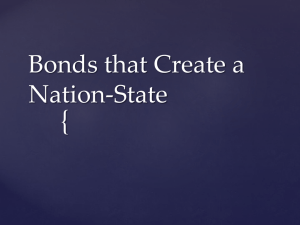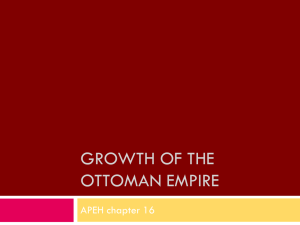Nationalism Around the World: 1919-1939 1
advertisement
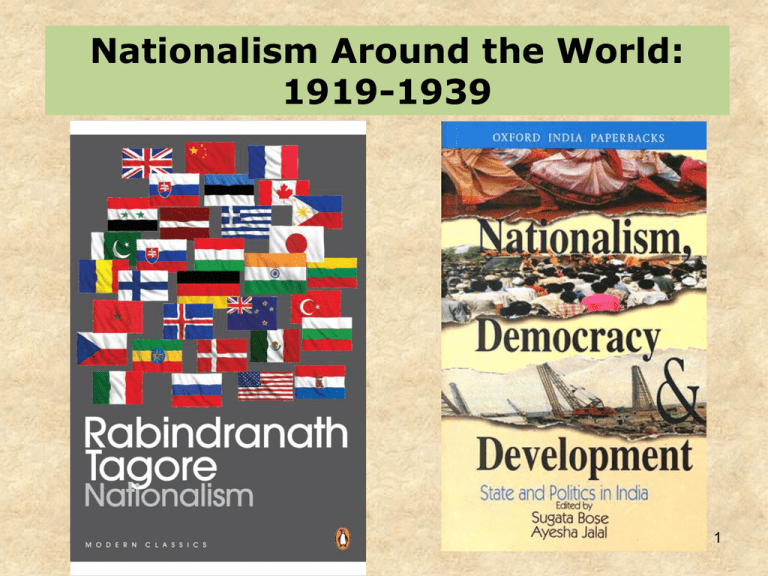
Nationalism Around the World: 1919-1939 1 PRODUCED BY Multimedia Learning, LLC http://www.multimedialearning.org WRITTEN BY HERSCHEL SARNOFF & DANA BAGDASARIAN COPYRIGHT 2006 VERSION 1.0 CONTACT INFORMATION: hsarnoff@gmail.com danabag@gmail.com 2 Chapter 10 Nationalism Around the World 1919-1939 Section 1: Nationalism in the Middle East 3 Nationalism had a dark and dangerous side. Many nationalists could not resist a sense of “we” and “they.” If each group was proudly promoting its uniqueness, character and spirit, this inevitably led to claims of superiority through comparisons with others, and a dangerous sense of national mission. Nationalism was a major cause of World War I in 1914 4 Decline and Fall of the Ottoman Empire The Middle Eastern Theater of World War I was fought primarily between the British and Russians against the Ottoman Empire and Germany. Fighting in the theater began on October 29, 1914. Hostilities ended on October 30, 1918. A final peace treaty was signed on August 10, 1920. This theater encompassed the largest territory of all the theaters of WWI. Yellow: Ottoman Empire Red: Battle Zones 5 Lawrence of Arabia The British government sent Captain T.E. Lawrence, known now as Lawrence of Arabia, to assist in the Arab Revolt. Sharif Hussein, the spiritual leader of Mecca, entered into an alliance with the Allies against the Ottomans in June 1916. Lawrence coordinated the Arab militias and made hit-and-run attacks on Turkish railways, forcing the Ottomans to send needed troops into the desert. In a historic attack, Lawrence led Arab militias across an impenetrable desert and seized the port city of Aqaba, cutting off supplies to the Ottoman army. This led to the Ottoman defeat at Megiddo. Top: Sharif Hussein Bottom: T.E. Lawrence 6 In September 1918 the Ottoman army was defeated in the Battle of Megiddo. Damascus was captured on September 30, 1918. This ended 600 years of Ottoman rule in the Middle East. Palestine Egypt Allenby 7 8 Armenians Lived in Eastern Turkey 9 Understanding the Armenian Genocide The Armenian Genocide refers to the systematic deportation and killing of Armenians by the Ottoman Empire from 1915 to 1918. The Ottoman government charged that Armenians were aiding the Russian Empire. The Ottoman government passed the Tehcir Law, giving the military authority to deport anyone it considered a threat to national security. The Ottomans confiscated Armenian property and deported, executed, and mass-murdered men, women, and children. The Ottoman army destroyed defenseless Armenian villages. 10 The Committee of Union and Progress The actions against the Armenians were directed by the Committee of Union and Progress (CUP). In February 1915, all military units with Armenian soldiers were demobilized. War Minister Enver Pasha justified this action "out of fear that they would collaborate with the Russians." Mass deportations began in May 1915. Enver Pasha Armenian Massacre at Erzingan 11 The Special Organization The CUP created a “special organization” comprised of criminals released to escort Armenian deportees to Syria. Entire families were forcibly marched, without food or water, to concentration camps in Syria. The deportees were often massacred by the soldiers or left at the mercy of murderers and thieves along the way. Armenians Being Marched to Syria Cartoon of Abdul Hamid II, Sultan of the Ottoman Empire 12 Turkey After the War Turkish court-martials were set up by Sultan Mehmed VI to punish the Committee of Union and Progress. The courts blamed the CUP for the atrocities committed against the Armenians, and for involving Turkey in the war. The Ottomans kept no records of the numbers of Armenians deported or killed. Estimates of deaths range from 300,000 by the modern Turkish state to 1,500,000 by modern-day Armenia. Western scholars place the number at 500,000. The Republic of Turkey does not accept this as genocide. Mehmed VI, the Last Sultan of the Ottoman Empire, Reigned 1918–1922 13 The Middle East After the Fall of the Ottoman Empire By the beginning of the 20th century, it was in political and economic crisis. For centuries, the Ottoman Empire dominated the Middle East, northern Africa, and southeast Europe. The empire entered WWI on the side of Germany. After the war, it collapsed. Turkey became a republic. 14 Colonialism vs. Self-Determination in the Post-Ottoman Middle East In the secret Sykes-Picot Agreement of 1916, France and Britain agreed on a plan for splitting up the Middle East after the expected fall of the Ottoman Empire. Imperial Russia was to gain control of Constantinople and the Turkish Straits. At the same time, to get the support of the Arabs against the Turks in WWI, Britain promised to support an Arab homeland encompassing much of the Middle East. In the Balfour Declaration of 1917, Britain also promised to support a Jewish homeland in Palestine. 15 San Remo and the Mandates • At the 1920 San Remo Conference, League of Nations leaders France, Britain, Italy and Japan met to determine the future of the Mideast. • Mideast lands were distributed in four "Class A Mandates" to be administered by France and Britain. Class A Mandates were territories that were considered to have reached "a stage of development where their existence as independent nations can be provisionally recognized subject to the rendering of administrative advice and assistance by a Mandatory until such time as they are able to stand alone. The wishes of these communities must be a principal consideration in the selection of the Mandatory." 16 The French Mandate of Syria lasted until 1943, when it was replaced by the independent nations of Syria and Lebanon. The British Mandate of Mesopotamia lasted until 1932, when Iraq gained limited independence. Britain maintained a military presence in the country. The mandate period was marked by conflicts over who would control Iraqi oil. Transjordan was an administrative division of the British Mandate of Palestine until 1946, when it became the independent kingdom of 17 Jordan. British Mandate in Palestine Britain administered Palestine from 1920 through 1948, when the State of Israel was founded. The mandate period was marked by conflict between the Jewish minority and the Arab majority. Britain favored establishing a Jewish homeland in Palestine, and encouraged Jewish immigration. The Jewish population rose from 10% to 30% during the mandate period. After the Arab Revolt (1936-39) Britain restricted Jewish immigration. High Commissioner Herbert Samuel arrives in Palestine in 1920 to head the Mandate. At right is Col. T. E. Lawrence18 (Lawrence of Arabia). Republic of Turkey Map shows the proposed division of Ottoman Empire, including Turkey proper, by the Treaty of Sèvres in 1920. Turkish nationalists objected to the partition of the Turkish heartland. Mustafa Kemal Ataturk, founder of the Republic of Turkey and its first president (1923-38) 19 The Modernization of Turkey Ataturk reformed the government of Turkey and made it more like a Western nation. Laws were made to ensure that religion was not in control of the government and people but freedom of religion was preserved. 20 From 1919-1922, Turkish forces under Ataturk resisted the Allied occupation on three fronts: First, against the French, who occupied portions of southeast Turkey; Next, against the Greeks, who had been promised territorial gains from the old Ottoman Empire and invaded western Turkey. On the third front, Trench warfare in the Greco-Turkish War of 1919–1922 Turks and Armenians fought over disputed territory in northeast Turkey. The conflict ended in 1923 with the Treaty of Lausanne, which established the modern Republic of 21 Turkey. Massive Population Exchanges and Ethnic Cleansing Resulted from the Greco-Turkish War of 1919-1922 Both sides committed massacres during the war. The Greek forces attacked Muslims and the Turkish forces attacked Christian Anatolian Greeks and Armenians. It has been estimated that Turkey systematically murdered over 500,000 Anatolian Greeks and 1,500,000 Armenians between 1916 and 1923. The U.S. ambassador to the Ottoman empire accused the Turkish government of a campaign of "outrageous terrorizing, cruel torturing, driving of women into harems, debauchery of innocent girls, the sale of many of them at 80 cents each, the murdering of hundreds of thousands and the deportation to and starvation in the desert of other hundreds of thousands, [and] the destruction of hundreds of villages and many cities," all as part of "the willful execution" of a "scheme to annihilate the Armenian, Greek and Syrian Christians of Turkey." In 1923 Greece and Turkey agreed to a population exchange: 1.5 million Greeks and Christians were expelled from Turkey and 22 500,000 Muslims were forced out of Greek territories. The Beginnings of Modern Iran Oil was discovered in Persia (Iran) in 1908 and Western companies became interested in development and control of the fields. Reza Khan (Reza Shah Pahlavi), an army officer, overthrew the government in 1922 and started to create a secular state like Turkey. In 1938 he renamed the country Iran and he began an independent foreign policy. His alignment with Nazi Germany led to his being deposed by the Allies during World War II. 23 Arab Nationalism Like Iran, Saudi Arabia, which had few people and was desert wasteland, had oil fields discovered during the 1930’s. Ibn Saud, had formed a kingdom of Saudi Arabia in 1932 and benefited from the wealth generated from the sale of oil. 24 Chapter 10 Nationalism Around the World 1919-1939 Section 2: Nationalism in Africa and Asia 25 Movements Toward Independence in Africa In the 1920’s Africans became much more politically active due to exposure of Colonial African soldiers to the West during their service in the World War. Returning to their homelands they saw the vast differences between Western democratic ideals and actual practice. This inspired reform and independence movements. 26 Movements Toward Independence in Africa Pan-Africanism was a movement to unite all Africans. This was supported by Black leaders Marcus Garvey and W.E.B. DuBois in the United States. Marcus Garvey W.E.B. DuBois 27 The Movement for Indian Independence 28 The Amritsar Massacre, April 13, 1919 Protestors in the Punjab region demanded the release of popular Indian leaders. British forces fired at them, leading to city-wide attacks on British property and a declaration of martial law by British authorities. Three days later, on April 13, British General Dryer fired into a crowd of unarmed Indians in the Jallianwala Bagh garden. Because they were trapped in a walled plaza with no escape, hundreds were wounded or killed. This event fueled the Indian independence movement. Punjab region 29 Mohandas Gandhi, 1869-1948 Mohandas Karamchand Gandhi Mohandas Gandhi, a Hindu, became the most influential leader of the Indian Independence Movement. While living in South Africa, he experienced discrimination, led successful protests, and later moved back to India with the goal of ejecting the British. He advocated non-violent resistance or satyagraha, meaning “soul force.” 30 Gandhi’s first use of satyagraha was the wearing of the dhoti. The dhoti is a traditional white garment made in India. He called on all Indians to only wear fabric made in India as a way to end British mercantilism. Gandhi and his wife Kasturbai, 1902 31 Gandhi in Kheda 1918 Gandhi next challenged the salt tax. Indians were forbidden to make their own salt. The revenues from taxing salt went to the British government in India. On March 12, 1930, Gandhi and 78 supporters walked 240 miles to the sea to make salt. 32 Gandhi during the Salt March Mahadev Desai and Gandhi On April 6, 1930, Gandhi was arrested for picking up sea salt. Tens of thousands of Indians were arrested by the British for making salt. Britain received worldwide condemnation for both the arrests 33 and brutality against Indians. During WWII Gandhi began the “Quit India” campaign to gain independence from Great Britain. He and his wife were put in prison, where she died. When India gained independence in 1947, Gandhi opposed the partitioning of the country into separate states. He believed India ought to remain one nation. 34 Indian National Congress Pandit Motilal Nehru Mohandas Karamchand Gandhi Sarojini Naidu Pandit Jawaharlal Nehru Hindu Indians organized the Indian National Congress in 35 1885 to bring about self-rule for India. Jawaharlal Nehru Jawaharlal Nehru, another leader of the Indian National Congress and close friend of Gandhi. He represented a more modern secular and Western approach for India.36 The Muslim League Indian Muslims formed the Muslim League in 1906 to work toward an independent Muslim state. Aga Khan III, one of the founders of the Muslim League. Sir Muhammad Iqbal, leader of the Muslim League, demanded a 37 separate Muslim state in India. Muhammad Ali Jinnah Muhammad Ali Jinnah became the leader of the Muslim League in the 1930’s. He believed in a separate Muslim state should be 38 created from northern parts of India. Partition During the partitioning there was widespread violence throughout India between Hindus, Sikhs, and Muslims. Millions of refugees left their homes to resettle across the new borders. On August 15, 1947, India became the two sovereign states of the Republic of India and Pakistan. Top: 1947 train to Pakistan Bottom: violence in Calcutta 39 The Rise of Militarist Japan 40 Zaibatsu Large monopolistic corporations (zaibatsu) created by the government controlled much of Japan’s economy. This caused an imbalance in the distribution of wealth and hardship on workers. This also led to a belief in the return to traditional values and rejection of Western influences. Militant nationalists became more influential in the government during the 1920’s and gradually took control over the civilians. This combined with the need for raw materials led to an aggressive expansionist policy and China was the most likely target. 41 Manchuria Japan had a lack of natural resources and a growing population so the military seized Manchuria in 1931, which was part of China, a vast source of natural resources. 42 Nationalism and Revolution in Asia Communist Russia offered support to nationalist movements throughout the world and became very influential in Asia. They trained and financed revolutionaries in many Asian countries but were most successful in China and Indochina. In French Indochina, Ho Chi Minh, was a typical nationalist-communist. 43 Chapter 10 Nationalism Around the World 1919-1939 Section 3: Revolutionary Chaos in China 44 Kuomintang (KMT) Kuomintang flag In July 1914, Sun Yat-sen established the Chinese Revolutionary Party, also called the Kuomintang (“kwow ming tang”). By 1915, China was controlled by a confederation of warlords under a central government in Beijing. 45 The Soviet Union In 1920 Sun Yat-sen asked the Soviet Union for assistance. The Soviet Union and Sun Yat-sen agreed to the following: Organize the KMT with the same constitution as the Soviet Communist Party. The KMT would ally with the Communist Party of China. The Soviets would train the new National Revolutionary Army under Sun Yat-sen’s Lieutenant, Chiang Kai-shek 46 (“Chee-yang Kai-shek”). In 1925, China had three different governments: •Chiang Kai-shek’s KMT in Nanjing. • The Communist Party of China (CPC) in Wuhan. • The internationally recognized warlord regime in Beijing. KMT Army 47 Chiang Kai-shek Cavalry of KMT Chiang Kai-shek began conquering the northern warlords with the help of the communists. By 1926 he had control of over half of China. Chiang Kai-shek took control of the KMT. He sent away the Soviet advisors. He turned on the communists and killed thousands in the Shanghai Massacre in April 1927. 48 Chinese soldiers, 1930 Impoverished Chinese family, 1930 Chiang Kai-shek had taken control of all major cities in China by 1928 and declared a new Chinese Republic. The major nations of the world recognized the KMT as the only legitimate power in China. 49 The Communists in Hiding The communists had to flee to rural areas to escape Nationalist attacks. Mao Zedong became the leader of the communists and used guerilla tactics to defeat the Nationalists who were more numerous and powerful. Mao addressing peasants and soldiers 50 The Long March Due to Nationalist attacks against his base of operations, Mao led the communist forces People’s Liberation Army (PLA) on a 6,000 mile march to a new base in Northern China, losing 90% of his troops in the process. 51 The New China of Chiang Kai-shek Chiang tried to fulfill the promises of Sun Yat-sen but believed he had to use dictatorial powers first to reform and modern China. His government still did not control all of China. He needed the support of the Chinese elite but this was in conflict with the peasants. As a result, he could not implement a land reform program which would have redistributed wealth from a small minority of wealthy landowners. His oppression of democratic principles led to the alienation of the peasants and drove them to favor the communists. 52 Chapter 10 Nationalism Around the World 1919-1939 Section 4: Nationalism in Latin America 53 The Latin American Economy Based mostly upon exporting foodstuffs and raw materials. The United States became a major investor in the export companies and thereby controlled major parts of the countries economies which angered many people. They saw the U.S. as another imperialist power. 54 The Good Neighbor Policy In 1933, President Roosevelt of the United States attempted to change the relationship by announcing the Good Neighbor Policy which rejected the use of military force by the U.S. against its Latin American neighbors. 55 Impact of the Great Depression Exports decreased due to the worldwide depression starting in 1929. With the decline in revenue, available capital for purchasing manufactured goods decreased and new local manufacturing developed with government investment and ownership. 56 The Move to Authoritarianism Domestic instability increased due to the depression and resulted in the creation of military dictatorships in many countries. Many countries had been ruled by small elites (oligarchies) with a pretense of democracy but this faded as military rulers took over. 57 Mexico Mexico although democratic was ruled by a one party system. The Institutional Revolutionary Party (PRI) was representative of the major groups of Mexican society and every six years nominated a presidential candidate who was then elected by the country. There were no serious opposition candidates. 58 Mexico President Lazaro Cardenas (1934-1940) instituted land reform and nationalized the oil industry. This made U.S. oil companies furious but U.S. President Roosevelt refused to intervene since he had issued a promise not to do so with his Good Neighbor Policy. 59 Culture in Latin America Mural by Diego Rivera Blending of traditional native styles of art with European styles became popular and promoted the history of the Latin America. 60 Self-Check Quiz Visit the Glencoe World History: Modern Times Web site at wh.mt.glencoe.com and click on Self-Check Quizzes-Chapter 10 to assess your knowledge of chapter content. 61

